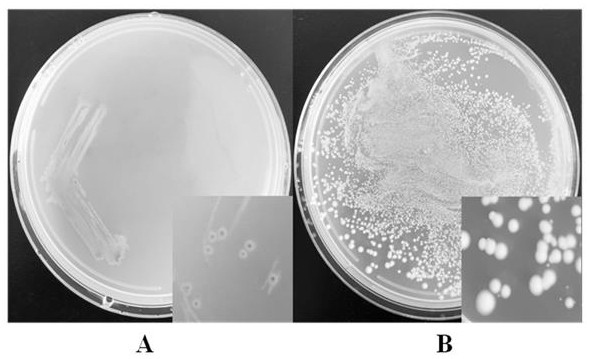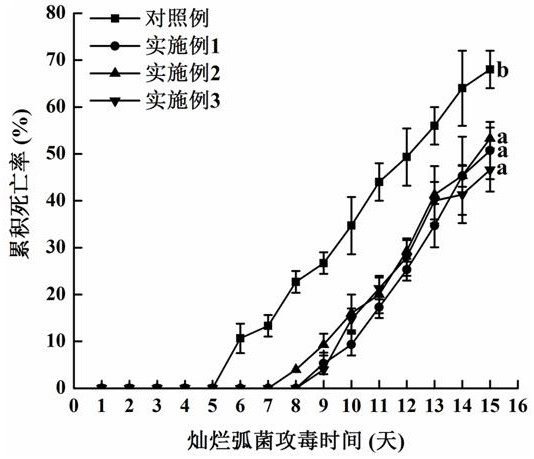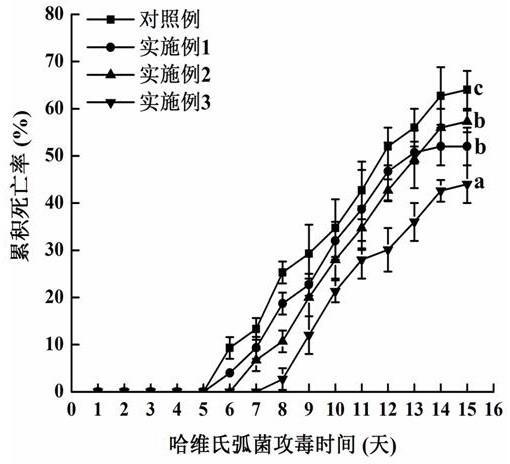Compound microecological preparation for breeding stichopus japonicus and inhibiting pathogenic vibrio
A composite microecological, pathogenic Vibrio technology, applied in the direction of microorganisms, microorganism-based methods, bacteria, etc.
- Summary
- Abstract
- Description
- Claims
- Application Information
AI Technical Summary
Problems solved by technology
Method used
Image
Examples
Embodiment 1
[0027] A kind of compound microecological preparation for cultivating sea cucumbers of the present invention to inhibit pathogenic Vibrio is composed of Rhodopseudomonas palustris ( Rhodopseudomonas palustris ), Clostridium butyricum ( Clostridium butyricum ), eucalyptus leaf extract and aloe vera leaf extract are mixed as feed additives, and Rhodopseudomonas palustris 10 per gram of feed is added 5 cfu, Clostridium butyricum 10 7 cfu, oak leaf extract 1 mg, aloe vera leaf extract 4 mg;
[0028] The eucalyptus leaf extract and aloe vera leaf extract are prepared according to the following method: the purchased eucalyptus leaves and aloe vera leaves are cleaned with distilled water, and dried in the shade at 25°C; , adding an ethanol solution with a volume fraction of 65%, and a solid-liquid ratio of 0.05 g / mL; leaching at room temperature for 1 h under the action of ultrasonic waves with a working frequency of 40 KHZ and a power of 80 W; put the leaching solution into an u...
Embodiment 2
[0038] The preparation process of Rhodopseudomonas palustris, Clostridium butyricum, oak leaf extract and aloe vera leaf extract is basically the same as in Example 1. The difference is that the cultivation temperature of Rhodopseudomonas palustris is 35 ℃, and the light intensity is 3000 lux. The volume fraction of ethanol extraction solution of oak leaf extract and aloe vera leaf extract was 85%, the solid-liquid ratio was 0.1 g / mL, and the extraction time was 2.5 h. Add Rhodopseudomonas palustris 10 per gram of feed 7 cfu, Clostridium butyricum 10 5 cfu, oak leaf extract 2 mg, aloe vera leaf extract 8 mg;
Embodiment 3
[0040] The preparation process of Rhodopseudomonas palustris, Clostridium butyricum, oak leaf extract and aloe vera leaf extract is basically the same as in Example 1. The difference is that the culture temperature of Rhodopseudomonas palustris is 33 ℃, and the light intensity is 2500 lux. The volume fraction of ethanol extraction solution of oak leaf extract and aloe vera leaf extract was 75%, the solid-liquid ratio was 0.07 g / mL, and the extraction time was 2 hours. Add Rhodopseudomonas palustris 10 per gram of feed 6 cfu, Clostridium butyricum 10 6 cfu, oak leaf extract 1.5 mg, aloe vera leaf extract 6 mg;
[0041] The colony morphology of Rhodopseudomonas palustris and Clostridium butyricum in embodiment 3 is as follows figure 1 As shown, Rhodopseudomonas palustris (A) is a maroon round colony with neat and smooth edges and a colony diameter of 0.3 mm to 0.60 mm; Clostridium butyricum (B) is a milky white round colony with a colony surface Smooth, raised, neat edges, ...
PUM
| Property | Measurement | Unit |
|---|---|---|
| Diameter | aaaaa | aaaaa |
| Diameter | aaaaa | aaaaa |
Abstract
Description
Claims
Application Information
 Login to View More
Login to View More - R&D
- Intellectual Property
- Life Sciences
- Materials
- Tech Scout
- Unparalleled Data Quality
- Higher Quality Content
- 60% Fewer Hallucinations
Browse by: Latest US Patents, China's latest patents, Technical Efficacy Thesaurus, Application Domain, Technology Topic, Popular Technical Reports.
© 2025 PatSnap. All rights reserved.Legal|Privacy policy|Modern Slavery Act Transparency Statement|Sitemap|About US| Contact US: help@patsnap.com



